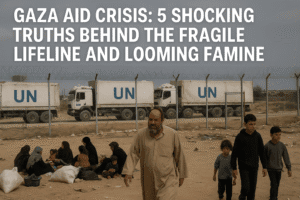Gaza Aid Crisis: 5 Shocking Truths Behind the Fragile Lifeline and Looming Famine
After an 11-week blockade, Israel has allowed a small, symbolic aid delivery to Gaza, where half a million people face imminent starvation amid one of the world’s worst humanitarian crises. Despite this limited gesture, the UN warns the aid is a mere “drop in the ocean” for Gaza’s 2.1 million residents suffering severe food shortages and displacement. Israeli military operations continue aggressively, causing mass casualties and worsening conditions, while political leaders remain divided over the aid’s purpose and distribution.
International condemnation grows as thousands of aid trucks remain stalled at Gaza’s borders, caught in bureaucratic and security hurdles. The blockade’s impact is catastrophic—children are dying from malnutrition, and families survive on minimal rations. With ceasefire talks stalled and no safe zones in Gaza, the crisis deepens under a shadow of escalating violence. The UN insists its neutral aid channels are vital, but political and military agendas threaten to politicize and limit relief efforts. The urgent question remains whether the world will move beyond words to secure lasting aid and peace, or watch Gaza’s famine become a forgotten tragedy.

Gaza Aid Crisis: 5 Shocking Truths Behind the Fragile Lifeline and Looming Famine
After an 11-week blockade that deepened one of the world’s most severe humanitarian crises, Israel has permitted a trickle of aid into Gaza, with five UN trucks carrying essentials like baby food entering via the Kerem Shalom crossing. The move, framed by Prime Minister Benjamin Netanyahu as a response to U.S. pressure and a strategic necessity to avoid famine, has been met with stark criticism. The UN calls the deliveries a “drop in the ocean” for Gaza’s 2.1 million residents, half a million of whom face imminent starvation.
Gaza Aid Crisis: 5 Shocking Truths Behind the Fragile Lifeline and Looming Famine
The Human Toll of Blockade and Bombardment
Gaza’s plight has reached catastrophic levels. The UN-backed IPC warns of famine conditions, with 57 children already dead from malnutrition-related causes. Displaced families, crammed into overcrowded shelters, describe surviving on a single meal a day. “My children go to sleep hungry,” shares Abd al-Fatah Hussein, a father sheltering in Khan Younis. Community kitchens, once a lifeline, are shutting down as supplies vanish. Meanwhile, Israeli airstrikes continue—reportedly killing 40 people in a single day, including five at a school-turned-shelter—as the military expands its ground offensive, ordering mass evacuations in southern Gaza.
Netanyahu’s Calculated Shift: Diplomacy or Survival Strategy?
Netanyahu’s decision to permit limited aid reflects a delicate balance between military objectives and international optics. While insisting Israel “must not reach a situation of famine,” he framed the move as pragmatic, citing concerns from U.S. allies over starvation imagery. Critics within his far-right coalition, like National Security Minister Itamar Ben-Gvir, decry the move as capitulation, while Finance Minister Bezalel Smotrich openly advocates for permanent displacement of Palestinians—a stance condemned globally.
The aid, however, comes with conditions. Netanyahu envisions a U.S.-backed plan to replace UN agencies with a new distribution network, allegedly to prevent Hamas from diverting supplies. The UN rejects this, citing neutrality principles and warning that militarized aid hubs would exclude vulnerable groups and normalize politicized relief efforts.
International Reactions: Condemnation and Empty Shelves
Global leaders, including the UK, France, and Canada, call Israel’s aid gesture “wholly inadequate,” threatening further action if restrictions persist. Yet, their leverage remains unclear. The UN stresses that 8,900 aid trucks sit idle at Gaza’s borders, with access obstructed by bureaucratic delays and security risks. On the ground, organizations like World Central Kitchen struggle to source ingredients at inflated prices, their efforts dwarfed by the scale of need.
The Shadow of Escalation
As Israel intensifies its offensive—vowing to “take control of all areas” of Gaza—the humanitarian crisis compounds. Over 53,000 Palestinians have been killed since October 2023, with 400,000 newly displaced since the blockade resumed. Civilians in Khan Younis face “unprecedented” military action, yet nowhere in Gaza is safe. Ceasefire talks remain stalled, with Hamas demanding an end to hostilities and Israel refusing until hostages are freed.
A Path Forward?
The resumption of aid, however minimal, underscores a grim reality: Without sustained access to food, water, and medicine, Gaza’s civilian toll will spiral further. The UN’s existing distribution networks, though imperfect, remain the most viable channel for aid at scale. Yet political posturing and military strategy continue to override human survival.
As global experts sound the alarm, the question lingers: Will the international community move beyond rhetoric to enforce a ceasefire and meaningful aid flow, or will Gaza’s famine become another footnote in a decades-long conflict? For now, families ration scraps, children succumb to hunger, and the world watches—a crisis shaped not just by war, but by the choices of those who could act.
You must be logged in to post a comment.